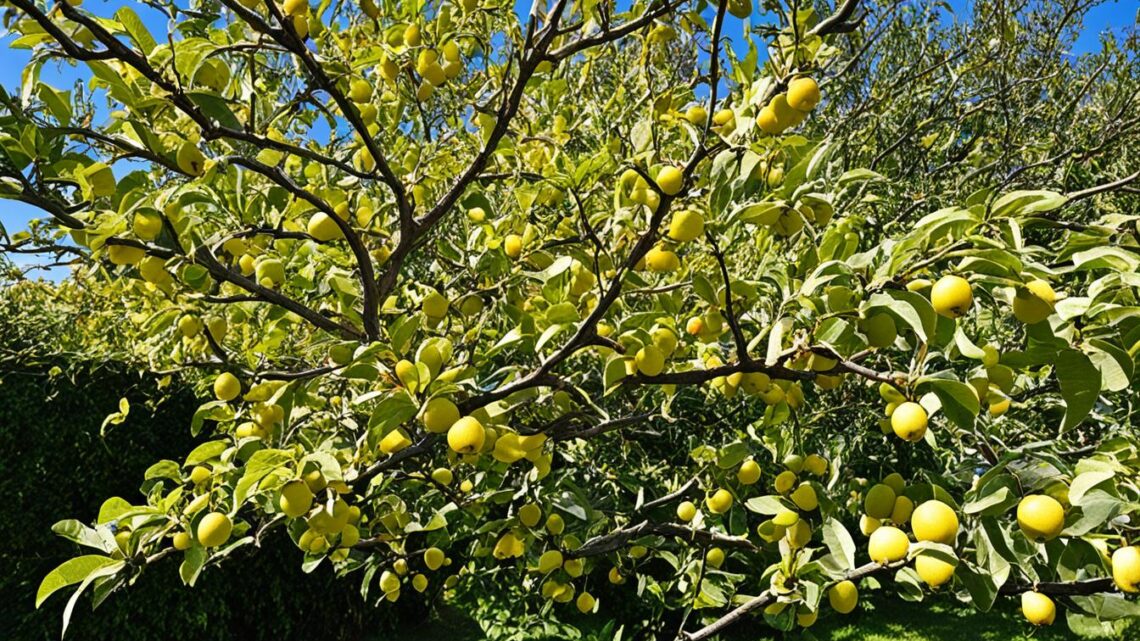
Have you ever seen your fruit trees suddenly wilt or have discolored fruits? Fruit trees can face many challenges, like pests, diseases, and environmental issues. But don’t worry, you can keep your trees healthy with the right care. It’s important to know the common problems and how to fix them.
This guide will cover the main common fruit tree problems. We’ll give you tips to spot, treat, and prevent these issues. By the end, you’ll know how to keep your trees healthy and full of fruit for a long time.
Identifying Common Pests on Fruit Trees
Fruit trees can face many pests. But, you can keep your orchard safe with the right steps. Aphids and leafhoppers are two pests you should watch out for.
Aphids: Tiny Sap-Sucking Pests
Aphids are small insects that suck sap from plants. This can make leaves look bad and sticky. They weaken the tree and slow its growth. Studies show that aphids can have many generations in one season. To fight them, use ladybugs or organic soaps.
Leafhoppers: Leaving Spots and Residue
Leafhoppers eat plant juices and leave spots and residue behind. This can ruin the look of the fruit. They are most active when it’s warm. Keep an eye on your trees during this time.
It’s important to spot and deal with these pests to keep your orchard healthy. Use organic and natural ways to control them. This will help your trees grow well and give you lots of fruit.
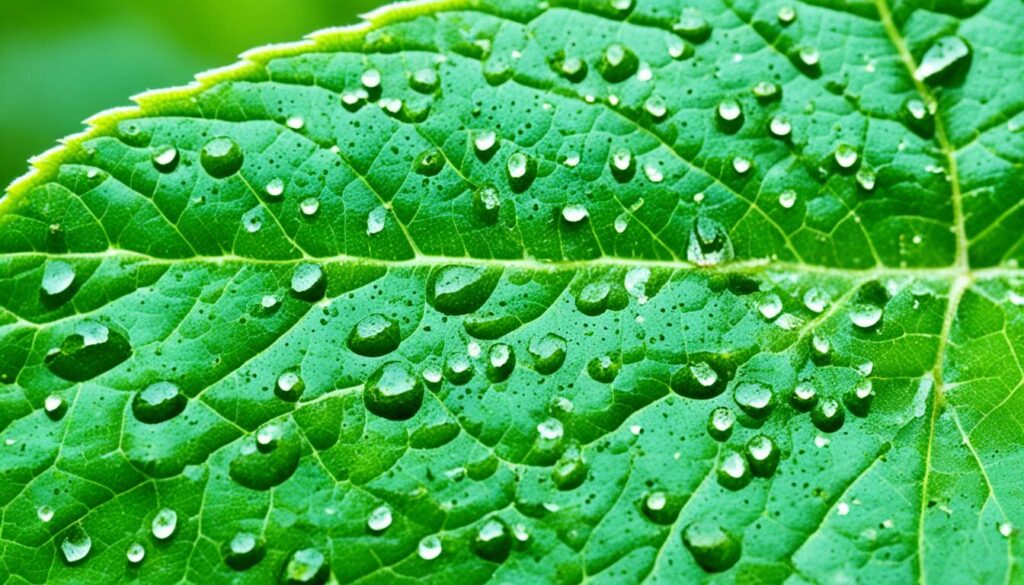
| Pest | Description | Damage | Control Measures |
|---|---|---|---|
| Aphids | Tiny, sap-sucking insects | Leaf discoloration, stunted growth | Introduce natural predators, use organic insecticidal soaps |
| Leafhoppers | Feed on plant juices, leave spots and residue | Disfigure fruit, make it unappetizing | Reduce weeds, use row covers |
Fruit Tree Diseases to Watch Out For
Keeping your fruit trees healthy is key for a good harvest. Apple scab and peach leaf curl are two common diseases to watch for. Knowing how to spot and handle these diseases helps your trees stay healthy.
Apple Scab: Disfiguring Apples and Leaves
Apple scab is a fungal disease that harms your apples and leaves. It makes the fruit and leaves look bad with brown, scabby spots and cracks. If not treated, it can make the tree weak and cut down on fruit.
Using fungicides and keeping your orchard clean are important steps to fight this disease.
Peach Leaf Curl: The Dreaded Disease
Peach leaf curl is a big problem for peach and nectarine trees. It makes leaves curl up and turn red or purple. Bad cases can lead to no leaves, less fruit, and a weak tree.
Using resistant trees and fungicides can help stop and control this disease.
Spotting and treating fruit tree diseases early is key to keeping your orchard healthy. By watching closely and taking the right steps, you can keep your fruit trees healthy and full of fruit for many years.
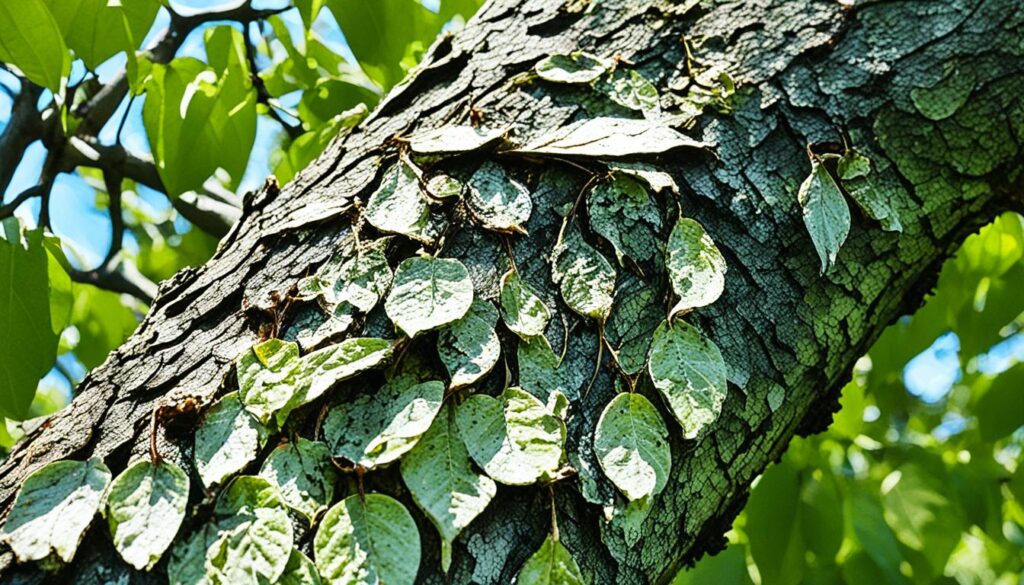
Dealing with Environmental Stresses
Fruit trees face many environmental challenges like drought, frost, heat, and poor soil. Knowing the signs of these issues helps you take steps to protect your trees. This way, they can get through tough times and bounce back stronger.
Drought makes leaves wilt, fruit fall early, and trees get weaker. Giving trees extra water during dry times keeps them healthy and strong.
Frost and cold temperatures hurt blossoms and new growth, cutting down on fruit. Using coverings or sprinklers during cold weather can stop frost from harming your trees.
Too much heat can burn leaves and make fruit sunburn. Trees with good mulch and proper pruning can handle the sun better.
Poor soil conditions, like hard soil or lack of nutrients, slow down tree growth and fruiting. Adding compost or other organic stuff to the soil helps trees grow better.
Transplanting fruit trees is a big stress. Planning the move well and giving trees extra care can help them settle in new places.
By paying attention to your fruit trees’ needs and fixing problems early, you help them beat environmental challenges. This way, they can keep giving you lots of fruit.
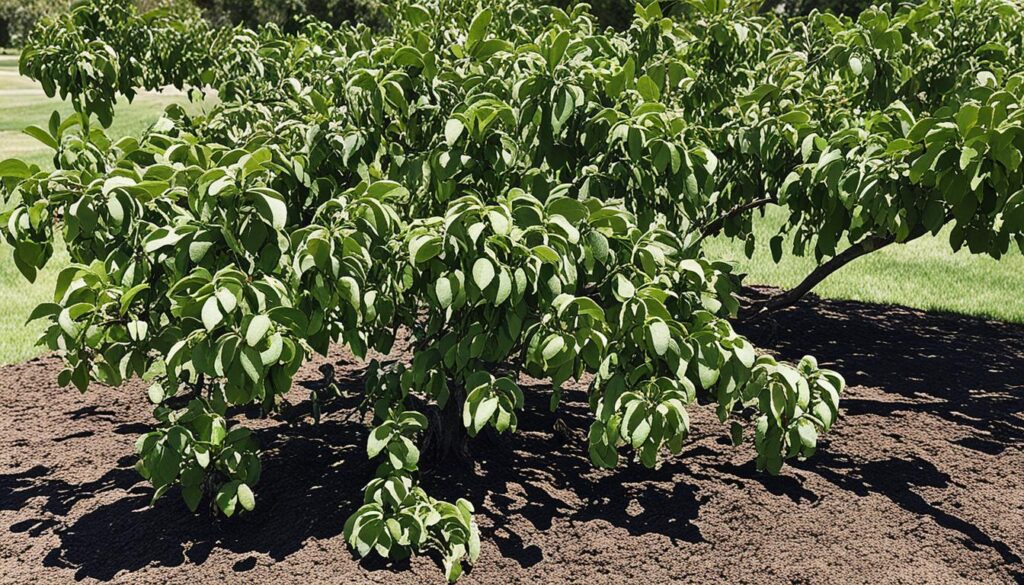
Pruning to Prevent common fruit tree problems
Proper pruning keeps your fruit trees healthy and productive. It stops many common problems before they start. Remove suckers and fix crossed or rubbing branches to keep your trees in top shape.
Removing Suckers and Crossed Branches
Suckers are strong shoots that grow from the base or trunk of a fruit tree. They take energy away from the main tree, slowing its growth and fruiting. Cutting these suckers is key to keeping your tree healthy.
It’s also vital to prune crossed or rubbing branches. These branches can let pests and diseases in, causing future problems. By cutting them, you improve air flow and lower the risk of these issues.
Using the best pruning methods keeps your fruit trees strong and full of life. Regular pruning shapes the tree and stops many common problems. It’s a smart move for tree care.
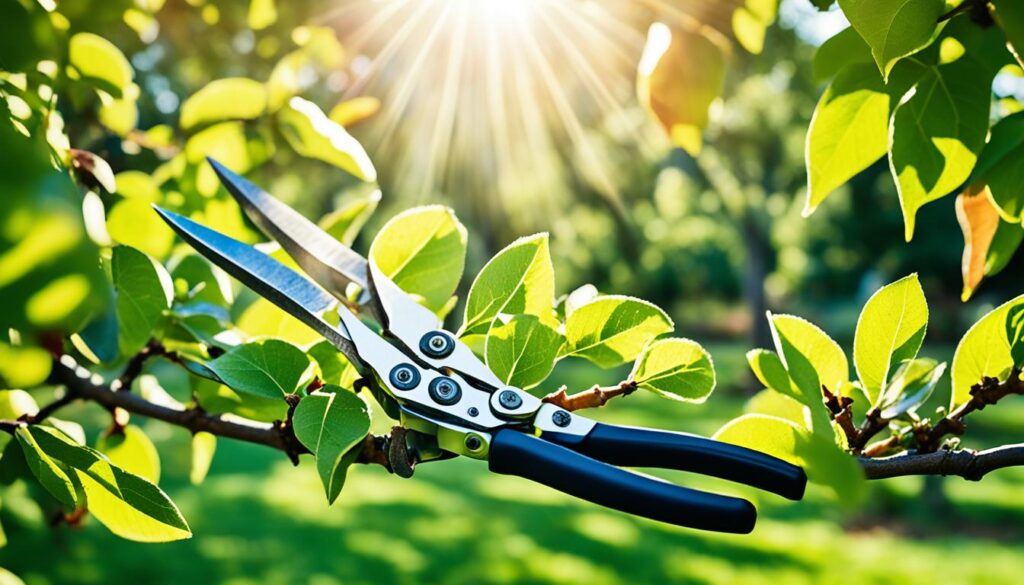
- Prune in the dormant season, usually in late winter or early spring, to reduce stress on the tree.
- Take out dead, damaged, or diseased branches to stop problems from spreading.
- Thin the tree’s inside to help air move better and let more light in.
- Avoid pruning too much, as it can make the tree more open to pests and diseases.
Being proactive with pruning keeps your trees healthy, productive, and free from common issues. With a bit of early care, you’ll have plenty of fruit for years.
common fruit tree problems: Nutrient Deficiencies
Keeping the right balance of nutrients is key for your fruit trees’ health and productivity. If your trees lack nitrogen, phosphorus, or potassium, they may grow poorly, have yellow leaves, and produce less fruit.
Nitrogen (N) deficiency is common and shows up on older leaves, making them turn yellow and fall off. Phosphorus (P) and potassium (K) deficiencies also hit older leaves hard. Calcium (Ca) deficiency affects new leaves the most.
Iron (Fe) deficiency can make leaves turn yellow with green veins, often from too high soil pH. Keeping soil pH between 4.5 and 6.0 helps iron get to your trees. Deficiencies in magnesium (Mg), sulfur (S), and manganese (Mn) can also hurt your trees’ health and look.
Fixing nutrient issues with the right fertilizers and soil care is key. Regular soil tests and targeted nutrients keep your trees healthy. This ensures they get the right balance of nutrients for soil health and nutrient availability.
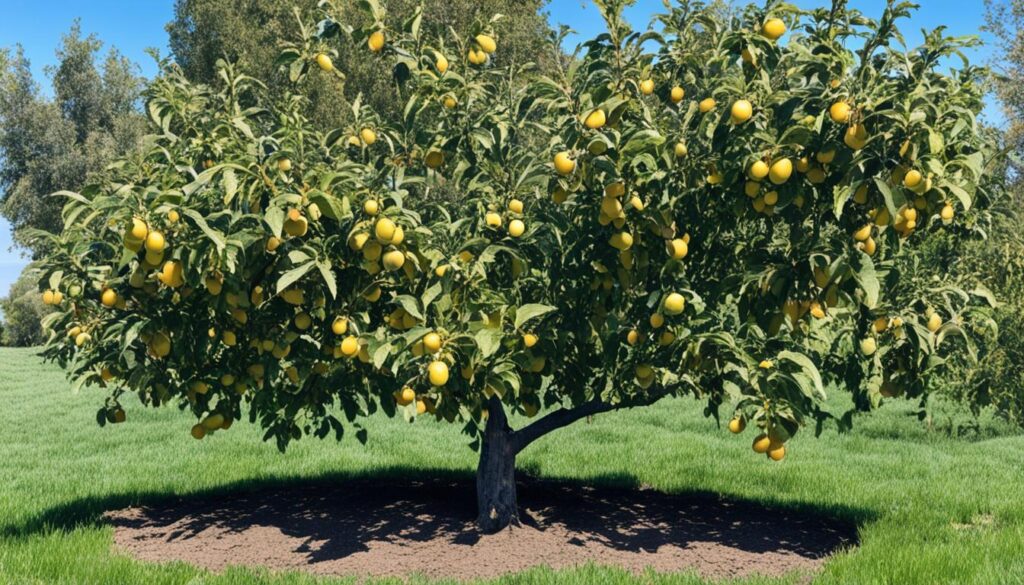
Knowing the signs of nutrient imbalance lets you fix them early. This way, your fruit trees get what they need for lots of good fruit every year.
Recognizing Fruit Drop and Its Causes
Fruit drop is when fruit falls off the tree too early. It can happen for many reasons, like environmental stress, pests, diseases, or bad growing habits. Knowing what causes it helps gardeners fix the problem and get more fruit.
Controlling Fruit Drop with Proper Care
Too much fruit drop can lose over 25% of the crop, especially in bad weather. June drop happens when young fruits and leaves fight for the same resources. Not having enough potassium can also make fruit drop worse, especially when there’s too much fruit.
Some fruits split more easily because of the weather, too much fruit, or certain types of trees. Fruits drying out too soon, or granulating, often happens in certain citrus fruits. This can be due to being too ripe, not enough water, or the tree being too strong.
Diseases like citrus canker and citrus greening can make trees lose leaves and drop fruit early. Alternaria brown spot can cause trees to die back, get leaf spots, and have sunken spots on the fruit.
New trees and those that carry too much fruit tend to drop more fruit. Not enough pollination, pests, or diseases can also make fruit drop worse, even in good conditions.
To stop fruit drop, gardeners can:
- Plant trees near their pollinators for better pollination.
- Thin the fruit, leaving about 4-6 inches between each one and breaking up clusters.
- Avoid using pesticides when the tree is blooming to protect helpful insects like bees.
- Keep the right amount of nutrients, especially potassium, for a healthy tree.
- Watch for and fix any pests or diseases that cause fruit drop.
Understanding why fruit drops and acting early can help gardeners have a great fruit harvest.
Branch Dieback: Signs and Solutions
Branch dieback is when parts of a tree’s branches die. It can happen for many reasons, like disease, pests, or stress. Knowing the signs and fixing the problems can help trees get better and stop getting worse.
Fire blight is a big problem for many trees, like apples and pears. It spreads fast and can kill branches or the whole tree. Sudden Oak Death is another disease that kills oak trees.
Anthracnose is a fungus that causes damage to many trees. It happens more in cool, wet weather. Raywood ash trees can get a disease that causes cankers and cracked bark.
Pests can also cause branch dieback. The Shot Hole Borer beetle is spreading fast in California. It harms many trees by bringing in fungi that cause dieback.
To fix branch dieback, find out what’s causing it and act fast. This might mean cutting off dead branches, using special sprays, or improving the soil. These steps help trees stay healthy.
By watching closely and acting early, tree owners can reduce branch dieback. This keeps their trees healthy for a long time.
Leaf Discoloration and Abnormalities
Leaf problems like discoloration and curl can mean many things. These issues might be due to fungal diseases, pests, or environmental factors. By looking closely at the leaves and spotting the symptoms, gardeners can figure out what’s wrong. Then, they can fix it with fungicides, pest control, or by changing the environment.
Fungal, Pest, or Environmental Causes
Many things can make leaves look bad:
- Fungal diseases like apple scab, peach leaf curl, and cherry leaf spot can change leaf color, spot them, and make them look odd.
- Pest infestations from bugs like aphids, leafhoppers, and mites can make leaves wilt, curl, and change color by sucking their sap.
- Environmental stresses from drought, not getting enough nutrients, or being sprayed with herbicides can also make leaves look bad and change color.
| Disease/Pest | Affected Varieties | Control Measures |
|---|---|---|
| Apple Scab | McIntosh, Cortland, Macoun | Weekly fungicide applications during green tip to petal fall period |
| Peach Leaf Curl | Avalon Pride, Betty, Elberta | One fungicide spray before bud burst in spring |
| Cherry Leaf Spot | N/A | Fungicide application before and after bloom |
Keep an eye on your fruit trees and fix any leaf problems fast. This way, you can keep your trees healthy and get a good harvest.
Fruit Rot Prevention and Management
Fruit rot makes fruit look bad, feel soft, and not good to eat. It’s often caused by fungal diseases that love humid or wet places. To stop this, keep air moving well, take out bad fruit, and use fungicides. This helps lower the chance of fruit rot and keeps the harvest healthy and big.
Brown rot is a big problem for stone fruits like peaches and plums. It can cause many issues, like making blossoms and branches sick. To fight this, make sure trees are pruned right to let air in and stop fruit from touching each other.
Scab is another fruit rot problem, hitting peaches and cherries. But thanks to fungicides, scab is now less of a worry in most orchards.
- Keep things clean by removing bad fruit and cutting out sick branches to stop fruit rot from spreading.
- Use fungicides at the right times to keep blossoms, twigs, and fruit safe from getting infected.
- Pick disease-resistant fruit tree types when you can to lower the chance of fruit rot.
By using preventative measures, keeping things clean, and choosing the right fungicides, fruit growers can beat fruit rot. This way, they get a healthy, top-quality harvest.
Wildlife Protection for Fruit Trees
Keeping fruit trees healthy means watching out for pests. Deer, birds, and rodents can harm your trees. It’s key to protect your trees to get a good harvest.
Deer can eat leaves, bark, and damage saplings. Use strong fences or deer-friendly plants to keep them away. You can also use sprays with predator smells or capsaicin to scare them off.
Birds like robins, starlings, and cedar waxwings can eat your fruit. Use nets or scare them away with sounds and shiny ribbons. This will help protect your trees.
Rodents, like squirrels and voles, can chew on trees and hide nuts in the soil. Use special fencing or cloth around your trees to keep them out. This will stop them from causing trouble.
| Pest | Exclusion Methods | Repellents |
|---|---|---|
| Deer | Sturdy fencing, deer-resistant plants | Predator urine, capsaicin-based sprays |
| Birds | Netting, audio deterrents, reflective ribbons | – |
| Rodents | Hardware cloth, rodent-proof fencing | – |
Use different ways to keep pests away and protect your trees. This will help keep your orchard healthy. Being proactive with pest control is key to protecting your fruit trees.
Helping Older Fruit Trees Thrive
As your fruit trees get older, they need special care to keep doing well and giving lots of fruit. Older trees can get a boost from pruning, getting the right nutrients, and keeping pests and diseases away. By taking care of their special needs, you can help these valuable trees keep thriving for many years.
Rejuvenation pruning is key for older fruit trees. It means cutting off old, dead branches and letting new, healthy ones grow. This makes the tree breathe better, gets more sunlight in, and helps it heal itself. Check out detailed guides on how to prune your fruit trees right.
It’s also important to manage nutrients for mature fruit trees. As trees get older, they might not have enough nutrients like nitrogen, phosphorus, and potassium. Giving them a slow-release fertilizer or compost can help. But don’t overdo it, or your tree might grow too much and not make as much fruit.
Keeping an eye on pests and diseases is a must for older fruit trees. These trees can get problems like aphids, leafhoppers, and fungal diseases. Check your trees often, fix any issues fast, and stay ahead to keep your trees healthy and strong.



